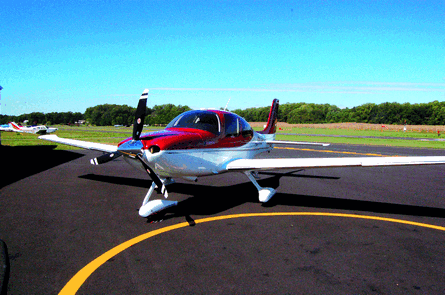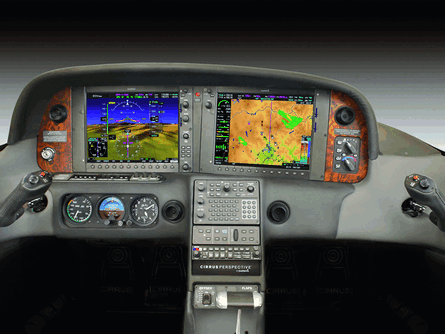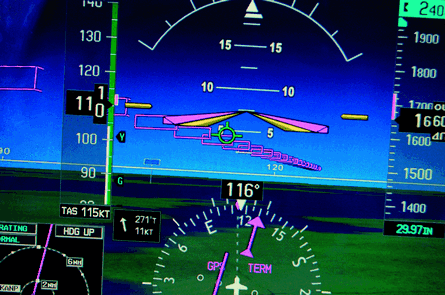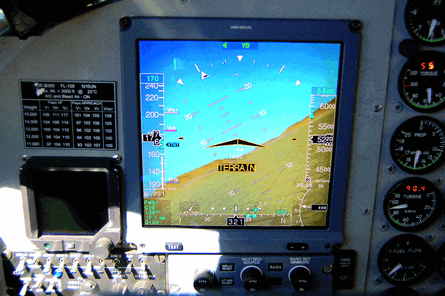Cirrus Design's new Perspective integrated avionics with Garmin-supplied displays and synthetic vision sets a new level of situational awareness for smaller general aviation aircraft that will make any manufacturer's offering without such features antiquated.
Flight International sampled the new system in a normally aspirated SR22-G3 on a demonstration flight from a small airport in Maryland with Cirrus mid-Atlantic sales representative and pilot Boni Caldeira. Cirrus is offering the Garmin cockpit as an option on normally aspirated and turbocharged SR22-G3 light aircraft for $48,000 more than the standard Avidyne Entegra integrated cockpit.
Two years in the making, the Perspective cockpit includes two 12in (305mm) LCD displays, one serving as the primary flight display (PFD) and the other as the multifunction display (MFD), each providing a 35% increase in viewing area compared with the 260mm Avidyne displays. Along with synthetic vision, the new platform includes a wealth of safety and efficiency enhancements that Cirrus says were designed to better integrate the pilot and the aircraft and enable a graceful degradation if there are failures.
 |
|---|
© John Croft/Flight International |
Cirrus has delivered about 200 aircraft with Perspective as an option since first deliveries in June and most customers have opted for the package to date, says Matthew Bergwall, Cirrus product and market strategy analyst.
The integration of pilot and aircraft is immediately apparent when the synthetic vision system (SVS) powers up on the PFD, located in front of the pilot and only centimetres below the non-instrumented glareshield. With the SVS display compressed to match the view through the forward windscreen, the pilot is wrapped in visual cues that remove many of the mental computations and transformations required in previous glass and "steam gauge" cockpits.
HEAD-UP PROCESSES
Navigation and communication are also head-up processes now, with pilots visually seeing information on MFD or PFD input from a centre console GCU 478 alphanumeric keyboard. By contrast, the Avidyne system uses dual Garmin 430s in the centre console for navigation and communication functions.
 |
|---|
© John Croft/Flight International |
A new crew alerting system on the right side of the PFD will alert the pilot to settings of interest, for example if the parking brake is left on after the aircraft starts to move, if the flaps were not raised after take-off and if the brakes overheat.
Perspective is also more robust, with two selectable GRS77 attitude and heading reference systems (AHRS), making it single-fault tolerant, compared with the Avidyne's single AHRS. Cirrus has also upgraded the back-up belt-driven alternator to 70 amp output from 20 amp, keeping the same 100 amp primary alternator for the 24v electrical system. Under a full flight load, the aircraft draws about 60 amp. Cirrus added a new GMC700 digital autopilot that provides smooth control in pitch and roll in all speed regimes, an increase in precision over Avidyne's analogue STEC 55X, an autopilot that ties into the turn co-ordinator instrument for roll and uses the input from the rate of climb indicator for pitch.
NEW YAW DAMPER
The digital autopilot is also used for input to a new yaw damper that greatly reduces the left-right swaying motion that can be uncomfortable, particularly for back-seat passengers in turbulence. Battery capacity has also been doubled, from two 12v, 7 amp batteries in series to two 12v, 12 amp batteries in series producing 24v and 24 amp to the electrical system. The circuit breaker panel has been reworked, with breakers in horizontal rather than vertical lines and colour coded for more visibility. Perspective uses dual GIA 63W GPS receivers, the same unit Garmin uses for the 430 and G1000.
Although Perspective offers similar features to high-end vision systems being offered for the business aviation market by avionics leaders like Honeywell and Rockwell Collins, the safety proposition offered by the technology truly shines when demonstrated on a general aviation mission, low to the ground, often outside positive air traffic control.
 |
|---|
© John Croft/Flight International |
RUNWAY CUE
After entering a flightplan via the keyboard, Caldeira taxied to the 760m (2,500ft) Runway 30 at Annapolis Lee airport, an uncontrolled airport east of Washington DC. Approaching the runway, the PFD prominently displayed the runway number in a large bold numbers, a cue that could help pilots avoid taking off on the wrong runway. Perspective also allows pilots to store up to 20 profiles to set preferences for day, night, visual or instrument flight.
On departure, the SVS appeared to be about 1m to the right of the hashed white centreline, although the aircraft was physically on the line, a reminder that wide area augmentation system GPS, although it is extremely accurate, is not perfect.
Caldeira had pre-selected the PFD to show a top-down view of transponder-equipped traffic out to 11km (6nm). Like the Avidyne system, Perspective gets its traffic information from an L-3 Skywatch module, which uses a single antenna on top of the SR22 to receive transponder signals from nearby aircraft. Traffic information can also be displayed top-down on the MFD, but more significantly, as objects in the synthetic vision display.
Distant traffic appears as a hollow white diamond at the appropriate altitude. As the threat gets closer, the diamond becomes solid white. Closer yet, the traffic marker becomes a yellow circle and the system annunciates the traffic alert. On our flight, the SVS traffic often exhibited a jerky motion, sometimes disappearing from the screen altogether. Although the traffic was in the correct position on average, the strong desire to believe the SVS information could be a cause for concern if the traffic is displayed incorrectly. Bergwall says the antenna can sometimes become blocked causing an intermittent signal that could cause traffic to disappear temporarily.
Terrain alerting is handled through the same 9 arcsecond (270m) database Garmin uses for the SVS (9 arcseconds is the granularity of the terrain database, which in this case represents one terrain elevation data point for every 270 x 270m square of turf). Perspective warns pilots of terrain issues via the traditional colour coded warnings on a top-down view on the MFD plus aural alerts, but also by highlighting offending terrain in yellow or red on the SVS. Obstacles too are shown and highlighted, first turning yellow and then red as the closing distance decreases.
Climbing though 1,500ft, the highway-in-the-sky (HITS) guidance appeared as a long string of magenta rectangles extending to the horizon above us at the selected altitude of 2,000ft. When hand flying the SR22 to join the HITS, the usefulness of the SVS flightpath marker (FPM), a hollow green circle with crosshairs, became apparent. Typically a feature of head-up guidance systems, the FPM shows the actual direction the aircraft is moving forward regardless of angle of attack or speed.
STALL SENSOR
In this case, the goal was to place the FPM marker in the most distant HITS box, a strategy that Caldeira says makes for a smooth capture of the desired flightpath. Having an FPM also raises the spectre of stalling an aircraft while attempting to reach an unattainable location, a potential Perspective addresses by having both a traditional stall speed system measured on the wing and a virtual stall speed "sensor" based on the aircraft's attitude and its computed flightpath.
 |
|---|
© John Croft/Flight International |
A new Perspective feature can help in situations where the aircraft might be responding differently than the pilot intended. Located on the centre console autopilot console is a blue button labelled LVL (level), which will take control of the aircraft from any orientation, levelling the wings and pitch attitude with the autopilot. Another safety feature for instrument approaches is the TOGA (take off/go around) switch on the underside of the throttle handle. Once activated, the TOGA function disconnects the autopilot and provides flight director guidance for the missed approach procedure.
Caldeira later showed how the FPM could be useful in an emergency such as an engine failure. Airports are displayed on the SVS by a vertical line connecting to a hollow box above. At 14.8km or closer, the box shows the name of the airport in text. Within 3.7km, the box is replaced with the runway layout. In a simulated engine failure at 3,000ft, Caldeira turned the SR22 toward the nearest airport, established best glide speed, placed the FPM on the runway and glided to a safe landing.
FORMER 3D GAMES MAN TURNS EXPERTISE TO SVS
Gaming industry aficionados might recognise the name Jed Margolin. He is one of the key engineers behind 1980s Atari arcade games like Battle Zone and Star Wars and 10 years from now, the Margolin name just might elicit similar recognition in the aviation industry for synthetic vision (SV) systems.
After leaving Atari in 1992 with 13 years in the business, Margolin began applying his knowledge of three-dimensional synthetic environments for the entertainment industry to solutions for a persistent problem in aviation - loss of situational awareness followed by controlled flight into terrain.
He had first considered the issue in 1985, after his supervisor at the time had lost a friend to a CFIT accident. "I looked at the work I was doing and thought, 'why don't pilots have something like this in their cockpits?'." Unfortunately two crucial ingredients were not yet available - GPS and terrain databases.
 |
|---|
© John Croft/Flight International |
In the mid-1990s, however, Margolin had access to both, and time on his hands to develop the "pilot aid using a synthetic environment", the name on his US patent number 5,566,073 ("073"), granted on 15 October 1996.
While industry giants like Honeywell and Harris had been researching the topic and obtaining relevant patents for more than a decade, Margolin says his approach - which includes representing terrain as a series of polygons anchored to a digital elevation database - amounted to "real" 3D where the others were attempting a two-dimensional representation that was not convincing.
"When I went to work for Atari in 1979, the conventional wisdom was that it was impossible to do real 3D because there were too many computations," he says. "I came with some algorithms that were mathematically precise and required fewer computations."
Atari initially used the algorithms in Battlezone, although Margolin did not patent the invention because algorithms were not then patentable, he says.
It is likely that many of the SV systems available or being developed use Margolin's intellectual property. Court documents revealed as part of a law suit between Universal Avionics and Optima Technology Group, the company that purchased Margolin's patents and represents him in such cases, show that Honeywell paid a one-time $475,000 fee to license patent 073 and to have first rights to purchase two related patents that use the algorithms for helping pilots fly unmanned air vehicles.
Geneva Aerospace, now a subsidiary of L-3, also licensed patent 073 and one of Margolin's UAV patents under a royalty arrangement.
Universal Avionics, however, continues to deny that Margolin's handiwork is present in its SV product, known as Vision 1. The company sued Optima in November 2007, "after repeated threats" that Optima would sue for patent infringement of 073 and one other patent, according to a Universal press release regarding a settlement between the two companies in September.
Optima had countersued, asking for a finding of infringement, damages and royalty on the products sold. Universal says that under the terms of the settlement agreement, it will "pay nothing" and be released from any future claims of infringement from Optima.
Despite claims from Universal's attorney that settlement "fully vindicates Universal's position that it did not infringe", sources have told Flight International that the actual agreement benefits Optima as well.
The larger issue from a market share perspective concerns whether other manufacturers, the most prominent being Garmin, might be infringing 073.
Given the sensitive nature of intellectual property, it is not surprising that independent inventors either avoid lawsuits or do not prevail against larger corporations.
Margolin says it is an "accepted statistic" that only 2-3% of independent inventors make money from their patents. And then there is the other little problem that all inventors face eventually - the intellectual property's sunset. Patent 073, granted in 1996, expires in 2013, opening the invention to any and all.
Source: Flight International























